Many gardeners swear by companion planting to reduce pests, boost yields, and improve plant health. If you’ve struggled with tomato plants (like me), it might be worth a try. While the jury is still out on its effectiveness, plenty of gardeners—including myself—have seen great results.
Through years of growing tomatoes, I’ve tried different companion planting methods—some worked, some didn’t. So if you’re wondering what are good companion plants for tomatoes, this guide breaks down what I’ve learned, so you can decide what’s worth trying in your own garden.

What is Companion Planting?
Companion planting is basically just growing different plants together in a way that benefits both. It’s a method inspired by natural ecosystems, where plants coexist and support each other. While the science behind some claims—like chives improving apple tree fruiting—might be unclear, gardeners often swear by it based on their experiences.
When it comes to layout companion planting tomatoes, it can take different forms, such as:
- Polyculture: Growing a mix of plants together to mimic natural environments.
- Intercropping: Planting crops close together to maximize space and resources.
Note: I went with intercropping for my tomatoes. It’s a great way to make the most of your garden space but keep things sort of organised.
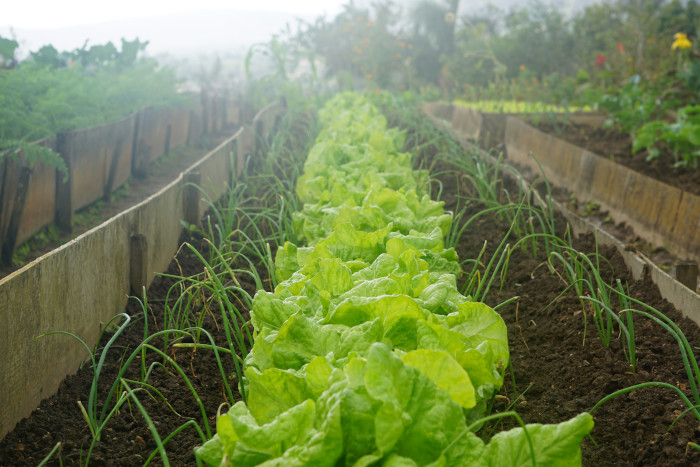
Why Companion Planting Works (And How It Can Help Your Tomatoes)
If you’ve faced challenges with pests, poor soil, or stunted growth, companion planting could be a tool for you to solve them. Here are some of the key benefits:
- Sacrificial Plants: These plants attract insects away from your main crops.
- Attracting Pollinators: Some plants draw in pollinators, increasing yields.
- Pest Control: Certain plants bring in natural predators that will take care of unwanted pests.
- Weed Suppression: Ground covers and other plants can outcompete weeds.
- Microclimate Improvement: Taller plants can provide shade for smaller ones in hot climates.
- Soil Health: Plants like legumes help fix nitrogen in the soil, which improves fertility.
- Disease Prevention: A more biodiverse garden can reduce disease spread by interrupting the life cycles of pathogens.
Tip: Rotate your crops and monitor plants regularly to prevent pests and diseases. Combine these practices with companion planting for healthier, more productive tomatoes.
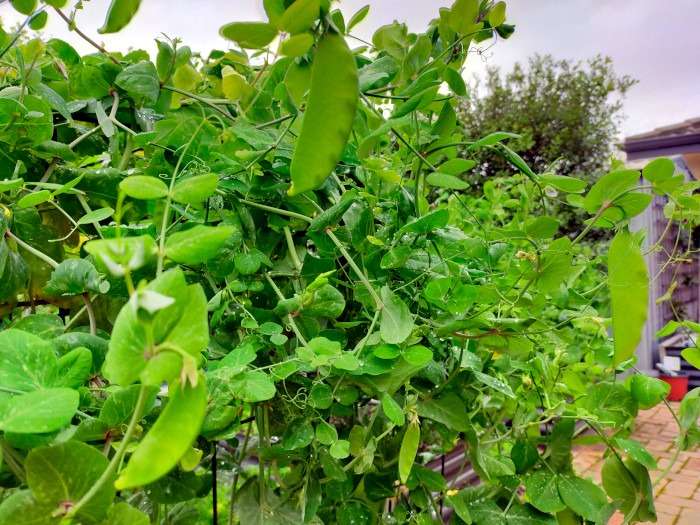
Top 5 Best Companion Plants for Tomatoes
There are many options when it comes to what to plant with tomatoes. I want to share what I’ve personally found works well for me, and hopefully, it’ll work for you too. These are some good companion plants for tomatoes that I’ve discovered over the years.
1. Spinach
Spinach takes the top spot for me as one of the best tomato companion plants. We eat a lot of spinach, so it’s one of my main crops each year.
Spinach has a shallow root system, while tomatoes have deep roots. This means they absorb nutrients at different soil layers, so they won’t compete for them. Both plants share similar water, nutrient, and sunlight needs, making them excellent companions.
Spinach grows low to the ground, and tomatoes can be trained to grow upward, which helps maximize space in the garden.
Tip: I space them a hands width apart, as spinach tends to spread.
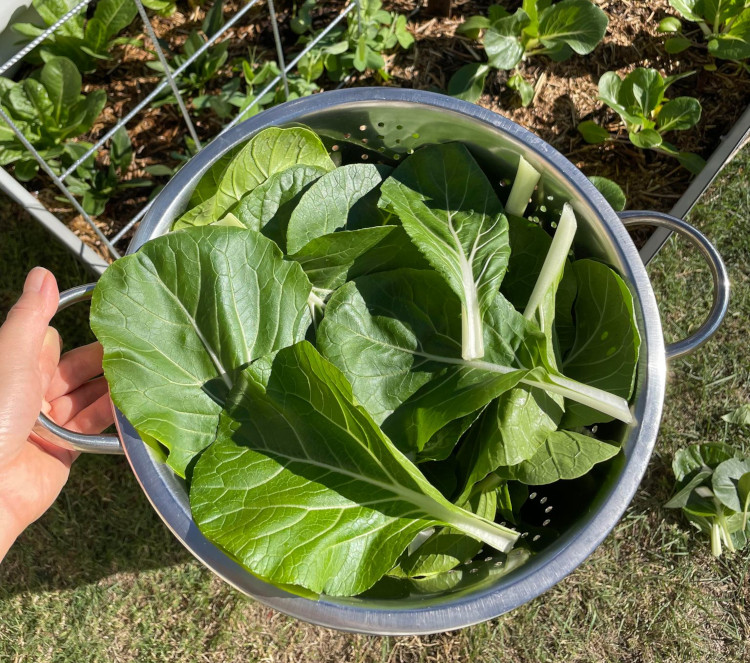
2. Basil
Basil is another one of my favourites for companion planting with tomatoes. It thrives in similar conditions and is easy to grow, making it an ideal companion. While some gardeners claim that basil enhances the flavour of tomatoes, I haven’t noticed a difference, but it’s still worth a try if you’re curious.
The strong scent of basil can help mask the aroma of tomatoes from pests like aphids and whiteflies. When planted around tomato plants, basil adds an extra layer of protection by concealing the tomatoes from these pests.
Additionally, basil’s flowering habit attracts beneficial insects, especially bees, which aid in pollinating tomato flowers. This could lead to a higher yield of fresh, ripe tomatoes in your garden.
Tip: I plant basil in any decently sized gaps in the bed, but constantly pick the leaves to keep them small and bushy.
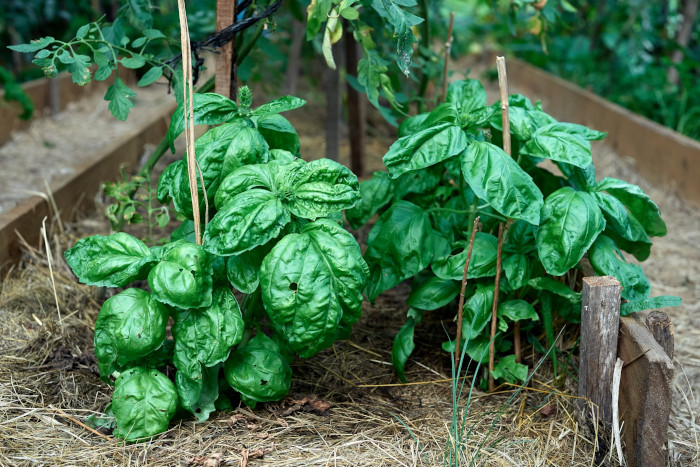
3. Marigold
Marigolds may not be useful in the kitchen, but they’re a great companion plant for tomatoes to keep bugs away. Hardy and low-maintenance, they self-seed and thrive with minimal care.
Spacing isn’t that important, but plant marigolds between your tomato plants so they provide good coverage. They repel nematodes, which can damage tomatoes, and their large, fragrant flowers attract pollinators to boost your tomato yield.
Marigolds also draw in beneficial predators like ladybugs and parasitic wasps, helping control aphids and other pests. Plus, they’re nice to look at.
Tip: There are a few different varieties of marigolds out there, but I don’t think it matters which kind you choose—just go for what you like.
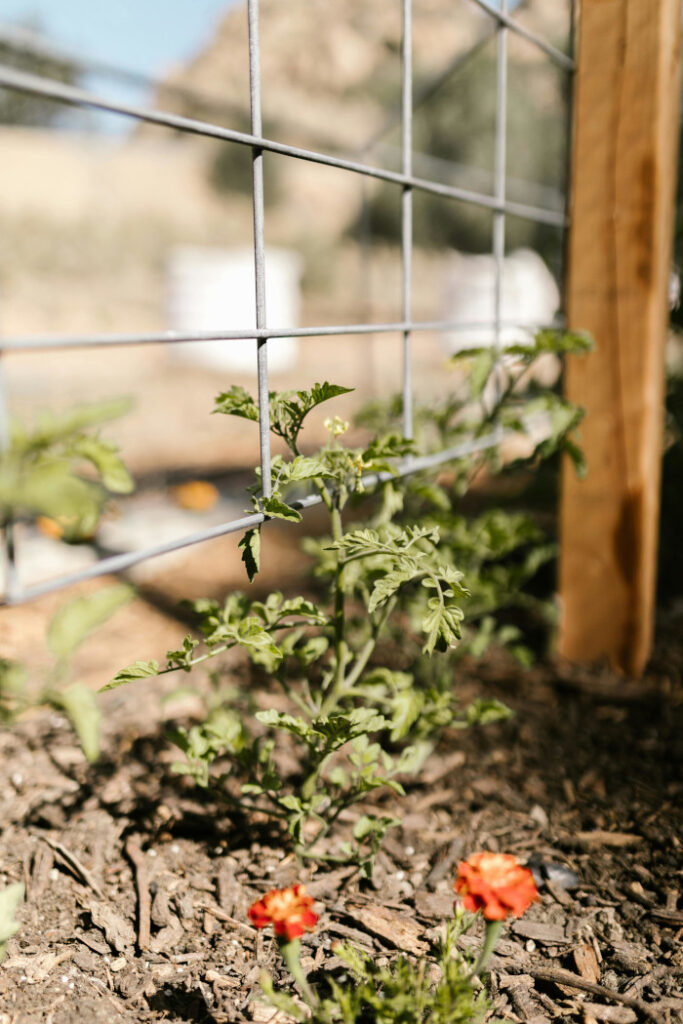
4. Spring Onions
Spring onions thrive in any nook and cranny of your garden, but recently I’ve found they work particularly well when planted with tomatoes. The extra light and water that tomatoes need will also give you great spring onion harvests.
Spring onions can act as sacrificial plants if needed—aphids tend to latch onto the onions, protecting your tomato plants. Since spring onions grow so quickly, you can easily chop off any infected leaves and keep them growing strong. If you’re wondering what to plant with tomatoes to keep bugs away, this is one of the best options.
Tip: I like to intercrop my spring onions with tomatoes, but you can chuck them in any gaps and it will work fine too.
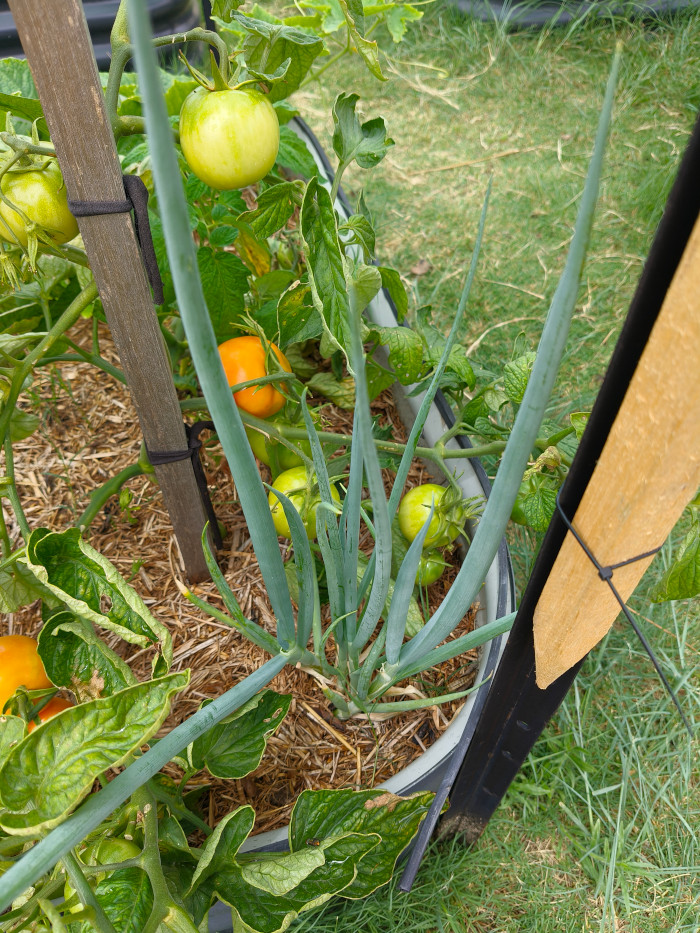
5. Lettuce
Lettuce, like spinach, is a fast-growing, shallow-rooted plant that pairs well with tomatoes. Plant it about a hand’s width away from the tomato plant, and the canopy can help protect the lettuce in warmer weather. Lettuce matures quickly, provides ground cover, and helps suppress weeds while retaining soil moisture.
That said, lettuce can be a bit fussy to manage compared to spinach, which is why I rank it a little lower. However, if you prefer the sweet, moist leaves of lettuce, it’s a great option to grow with tomatoes.
Tip: Lettuce tends to bolt in hot weather. If you’re planting them with tomatoes, consider using a shade cloth to help keep the lettuce cool and prevent it from bolting.

Bad Companion Plants for Tomatoes
Tomatoes are heavy feeders, meaning they need a lot of nutrients to produce a good harvest. When planted alongside other heavy feeders, tomatoes compete for nutrients, leading to smaller fruits and fewer of them. This can be a disaster for any backyard grower.
Some heavy feeders to avoid planting with tomatoes include:
- Corn
- Broccoli
- Cabbage
- Cauliflower
- Brussels sprouts
Tip: Avoid deep-rooted plants or heavy feeders when choosing companion plants for tomatoes.

Good Companion Plants for Tomatoes
As a general rule, shallow-rooted, leafy greens make a good companion plants for tomatoes. You can also consider:
- Radishes: They grow quickly and help break up compacted soil, improving aeration for tomato roots.
- Cucumbers: These plants provide ground cover, helping with weed suppression and reducing water evaporation.
- Squash: Squash spreads out, covering the soil, preventing weeds, and retaining moisture. They also offer some shade to tomato roots during hot weather.
- Peppers: Peppers have similar growing requirements to tomatoes, including sunlight, water, and temperature, but don’t compete for nutrients.
Tip: Carrots are often praised as a good companion for tomatoes. However, if you plant them together you won’t get big, straight carrots. In my experience carrots are better grown in their own special raised bed.
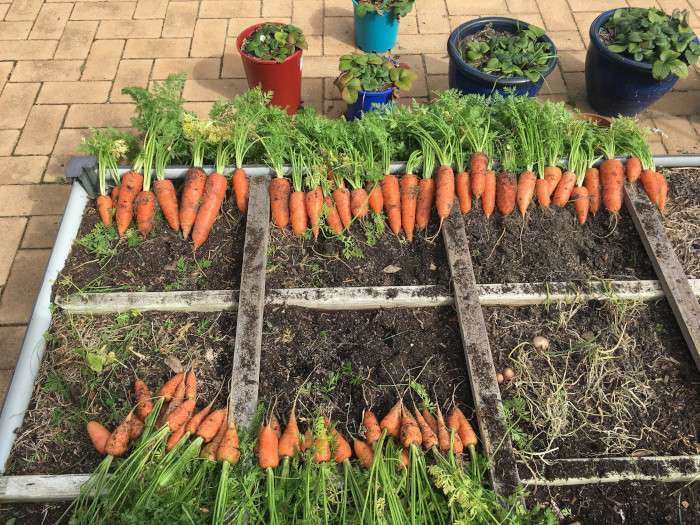
What Herbs to Plant with Tomatoes
I recommend planting annual herbs with your tomatoes, as tomatoes are usually replanted each year.
Good options include:
- Basil: A classic companion, basil not only pairs well with tomatoes in the kitchen, but it also helps deter pests like mosquitoes and flies.
- Cilantro: Grows quickly, attracts beneficial insects like ladybugs.
- Dill: Its tall structure offers some light shade and attracts beneficial insects, helping to keep pests at bay.
Tip: It doesn’t make sense to plant perennial herbs in the same bed with your tomatoes since they will stay longer than your tomato plants. Instead, consider planting them in pots or containers nearby.
What to Plant with Tomatoes in a Container
When growing tomatoes in containers, you can maximize space and productivity by planting herbs nearby or even in the same container. Here are some great options:
- Lemongrass: Adds a fragrant touch and helps repel mosquitoes and other pests, making it a perfect companion for tomatoes in a container.
- Thyme: A low-growing herb that acts as a living mulch, thyme suppresses weeds and helps retain moisture, all while offering a pleasant aroma.
In the container itself, you can plant any of the good companion plants we’ve mentioned so far, like basil, cilantro, dill, or most of the leafy greens.
Tip: Raised beds are a great form of container gardening.

What Flowers to Plant with Tomatoes
Marigold is the top flower I would suggest planting with tomatoes. Other good options include:
- Nasturtiums: Their vibrant flowers attract beneficial insects and help repel aphids and whiteflies.
- Zinnias: These flowers attract pollinators like bees and butterflies.
- Calendula: Known for its pest-repelling properties, calendula helps keep harmful insects away from tomato plants.
- Petunias: They add colour and also help deter pests like aphids and beetles.
- Borage: With its nice blue flowers, borage attracts pollinators, also very hardy.
Tip: Many of these flowers are self-seeding and can spread quickly, so consider planting them in pots to keep them controlled.
Peppers and Tomatoes Companion Planting (Chillies)
I don’t plant them directly next to each other, but I do keep them in the same bed since they share similar growing conditions, like plenty of water and sunlight. You can intercrop them with companion plants like marigolds, basil, or onions.
The tomatoes and peppers are the main focus, and the other plants are there to fill in the gaps and offer their natural benefits.
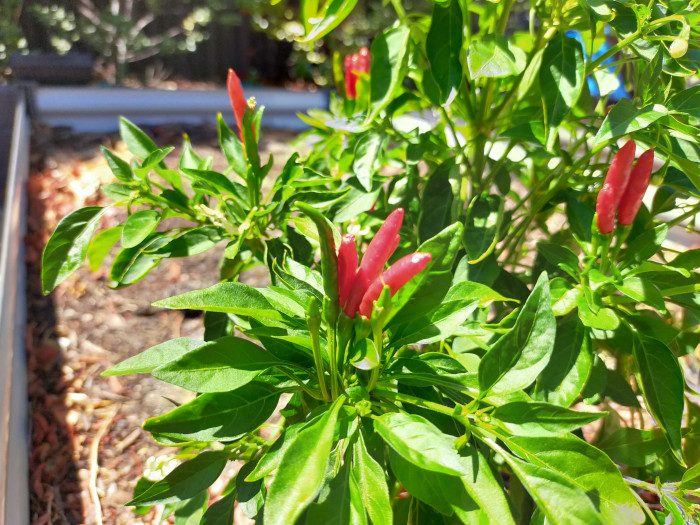
Conclusion
Companion planting mimics natural systems to boost productivity and biodiversity. By pairing tomatoes with leafy greens or herbs like basil, you create a resilient growing environment that maximizes space, aids pest control, enhances pollination, and improves soil health. This all contributes to a more productive tomato harvest.
Give companion planting a go and see how it works for you.

